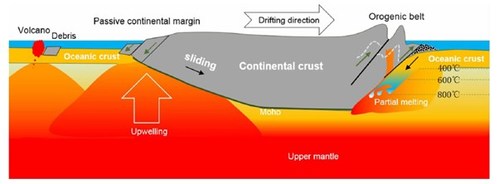BEIJING, March 1, 2022 /PRNewswire/ — The breakup of the South Atlantic region, which led to the separation of the African and South American continents, is a well-known global phenomenon and the basis of the famous continental drift theory put forth by the German climatologist, Alfred Wegener. According to this theory, the continental plate floats on the oceanic crust and, powered by the Earth’s rotation and tidal energy, drifts relative to it. However, the driving forces behind these continental plate movements are still debated. Specifically, none of the hypotheses put forth can explain why the opening of the Atlantic Ocean is wider in the south than in the middle.
Now, in a new study published in Earth Science Frontiers, researchers from China seem to have finally solved the conundrum. The team comprising Dr. Liang Guanghe from Chinese Academy of Sciences and Prof. Yang Weiran from China University of Geosciences have proposed a new model that suggests that the main driving force is supplied by a gravitational slip of the continental crust and hot mantle upwelling. One can picture this better by imagining a slab of butter floating a hot pan, which can move in any direction by itself.
How did the duo accomplish this feat? To start with, they studied two deep seismic reflection survey profiles across the Atlantic Ocean, and calculated the magnitude of crustal gravitational slip shear force in the African continent along Moho (the boundary layer between the earth’s crust and mantle), in two passive continental margin basins.
This led to two important findings: the continental drift relies on its own gravity to drift via constant rising of the mantle, suggesting that the gravitational slip force is the main driver, and the slip only occurs on the Moho surface due to the greater thickness of the continental crust as compared to that of the oceanic crust, causing the drift to produce an even greater gravity slip.
"The resultant mantle upwelling leads to an inclined Moho surface, on which the continental plate begins to slide, owing to its own weight," explains Dr. Liang Guanghe. "This continuous movement of continental plates causes further mantle upwelling and steepening of the Moho slope, eventually resulting in the drifting of the continental plate above the oceanic plate."
Using this model, the team found that the driving force behind the African plate movement along the Moho is greater in the South than in the middle South Atlantic region, causing the southern part of the African region to drift at a much greater speed. This explained the wider opening of the southern part of the Atlantic Ocean.
What are the implications of these findings? Dr. Liang uanghe says, "While Wegener was right about continental drift, he was wrong about the driving force. The new explanation offered by our model will vastly change the way people understand the movement of plates on earth."
That, indeed, deserves to be called "groundbreaking." The finding has been converted into this video summary: https://youtu.be/zInxB6rdZtQ
Reference
Title of original paper: Decipher the driving force in continental drift from new insights about the South Atlantic breakup process
Journal: Earth Science Frontiers
DOI: https://doi.org/10.13745/j.esf.sf.2021.12.27-en
Contact:
Xiaolong Wang
13522262702
330825@email4pr.com
SOURCE Earth Science Frontiers


